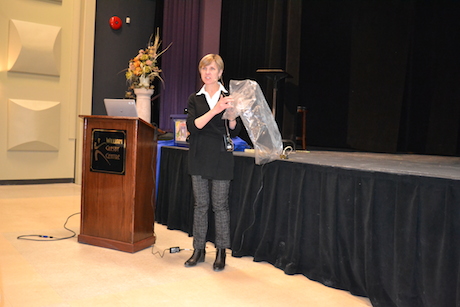Dr. Denise Beaulieu, a research scientist in nutrition with the Prairie Swine Centre says lower feed costs and higher live hog prices are allowing pork producers to refocus on maximizing the productivity of their herds.
Beaulieu told producers at a recent Prairie Swine Centre producer meeting the big change in the past few months is the drop in the cost of feed grains and the increase in pig prices. This means producers can shift their focus away from decreasing the cost of feed and look at investing more money to increase the rate of gain of those animals.
“We’re still seeing these changes happening,” she said. “But certainly we could put some more money perhaps into the feed where we were really focused before on doing everything we could to decrease the cost of feed and it was profitable even if it meant slowing the rate of growth down.”
Beaulieu says however now, with the increased futures prices for the pigs, a producer could spend a little bit more money for their feed if it means increasing the rate of gain of those animals so they can afford to invest once again in the feed if it improves the performance of those animals.
“What the producer always wants to be concerned about is their net returns so they need to model their whole system, not just look at one component in isolation,” she said. “If they’re going to put a little bit more money into their feed they have to know how that affects the performance of those animals. And what they get from those animals as an overall return when they sell those pigs and so they have to be able to know the return on that investment just like any other business.”
Dr. Beaulieu encourages producers to review their least cost diet formulations, to take full advantage of the positive changes. Each producer needs to re-evaluate their own system, go through all of their diets, and perhaps reformulate those diets.
She believes it is a combination of treating the animal better and helping the producer make more money now that the producer has better margins and more cash flow.
“Our goal would be for example to help the producers make more money that allows him to treat the animals better and vice versa,” said Dr. Beaulieu. “Not that they’re not treating them well now, but to improve their care and welfare, and still be able to make money.”
She says the past several years to optimize net returns wasn’t always perhaps growing the pig at an optimal average daily gain. It paid most producers to make more money by decreasing feed costs even if it meant the pigs weren’t growing quite so fast.
“However, we think now the situation is changing and has changed quickly enough to kind of rethink that scenario,” said Beaulieu. “Dietary costs could increase and you could still improve your net returns if you can increase the daily gain of those animals and maintain carcass values.”
For example, the producer could reformulate their diets by looking at the model on their own farm.
“If they increase average daily gain, look at the returns they would get for that and how many more animals could they put through that barn in a year if they shorten the days to market and that is just one example,” she said.
With producers trying to recoup losses, and some bigger losses than others, does this encourage or tempt some producers to make some short turn gain quickly.
“I don’t see them taking real short cuts but we hope that what they do is that they perhaps change their focus,” said Beaulieu. “They are going to make money, but how can they really optimize those returns and make as much as possible so they have a little to go to the bank and invest in their facilities. Many have facilities that need some investment because producers made very little barn improvements over the past five years.” •
— By Harry Siemens




